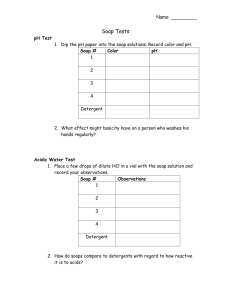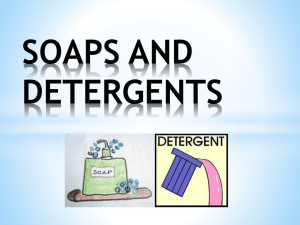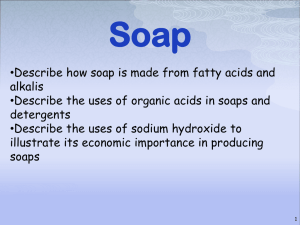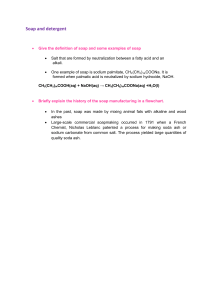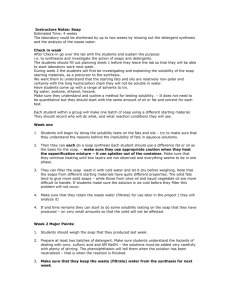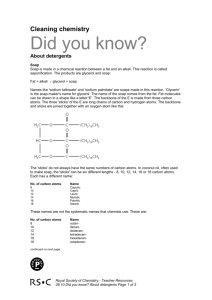THE SCIENCE OF SOAPS AND DETERGENTS
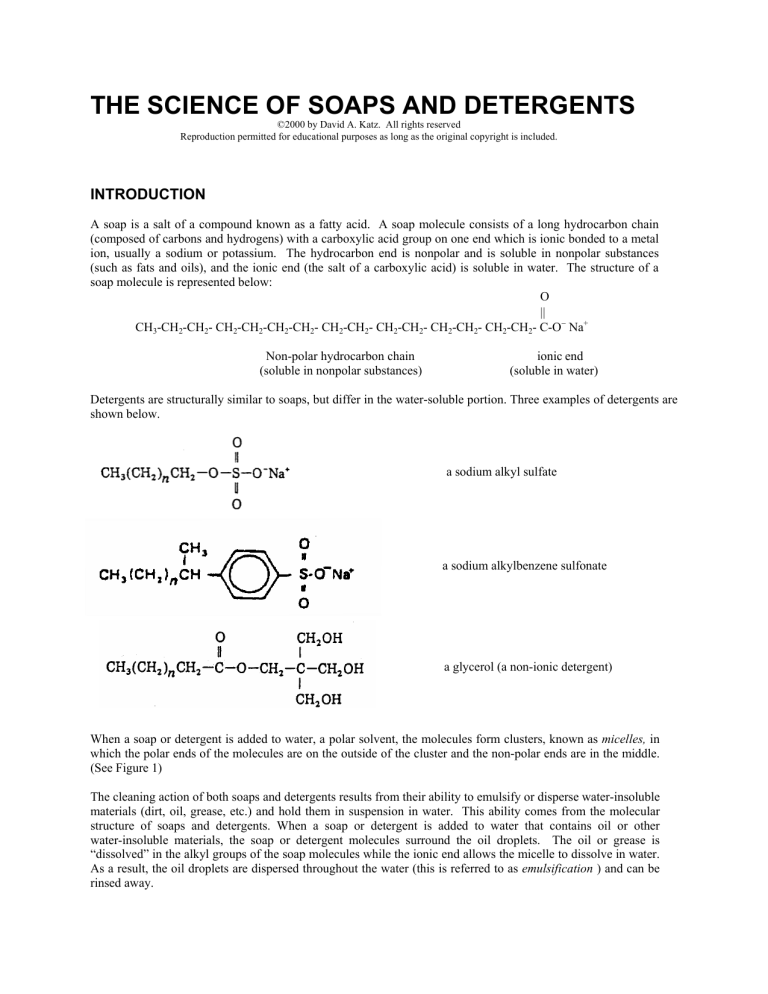
THE SCIENCE OF SOAPS AND DETERGENTS
©2000 by David A. Katz. All rights reserved
Reproduction permitted for educational purposes as long as the original copyright is included.
INTRODUCTION
A soap is a salt of a compound known as a fatty acid. A soap molecule consists of a long hydrocarbon chain
(composed of carbons and hydrogens) with a carboxylic acid group on one end which is ionic bonded to a metal ion, usually a sodium or potassium. The hydrocarbon end is nonpolar and is soluble in nonpolar substances
(such as fats and oils), and the ionic end (the salt of a carboxylic acid) is soluble in water. The structure of a soap molecule is represented below:
O
||
CH
3
-CH
2
-CH
2
- CH
2
-CH
2
-CH
2
-CH
2
- CH
2
-CH
2
- CH
2
-CH
2
- CH
2
-CH
2
- CH
2
-CH
2
- C-O
−
Na +
Non-polar hydrocarbon chain ionic end
(soluble in nonpolar substances) (soluble in water)
Detergents are structurally similar to soaps, but differ in the water-soluble portion. Three examples of detergents are shown below.
a sodium alkyl sulfate
a sodium alkylbenzene sulfonate
a glycerol (a non-ionic detergent)
When a soap or detergent is added to water, a polar solvent, the molecules form clusters, known as micelles, in which the polar ends of the molecules are on the outside of the cluster and the non-polar ends are in the middle.
(See Figure 1)
The cleaning action of both soaps and detergents results from their ability to emulsify or disperse water-insoluble materials (dirt, oil, grease, etc.) and hold them in suspension in water. This ability comes from the molecular structure of soaps and detergents. When a soap or detergent is added to water that contains oil or other water-insoluble materials, the soap or detergent molecules surround the oil droplets. The oil or grease is
“dissolved” in the alkyl groups of the soap molecules while the ionic end allows the micelle to dissolve in water.
As a result, the oil droplets are dispersed throughout the water (this is referred to as emulsification ) and can be rinsed away.
Soaps, will react with metal ions in the water and can form insoluble precipitates. The precipitates can be seen in the soapy water and are referred to as “soap scum”. This soap scum can form deposits on clothes causing them to be gray or yellow in color. To eliminate the metal ions in water, washing aids such as washing soda (sodium carbonate) and borax (sodium tetraborate) were added to the wash water. These compounds would precipitate the metal ions, eliminating most of the soap scum. With the discovery of synthetic detergents, much of the need for washing aids was reduced. A detergent works similar to a soap, but does not form precipitates with metal ions, reducing the discoloration of clothes due to the precipitated soap.
Modern laundry detergents are mixtures of detergent, water softeners, optical brighteners, stain removers, and enzymes.
SAFETY PRECAUTIONS
Wear goggles or safety glasses at all times in the laboratory.
Figure 1. A diagram of a soap micelle surrounded by water molecules. The lines in the center represent grease and oil.
Sodium hydroxide is caustic. Avoid skin contact . In the event of contact with your skin, was the affected areas well with water until your skin no longer feels soapy. If redness occurs, consult qualified medical assistance.
Ethanol is flammable. Keep the container covered and take care to avoid flames.
Sulfuric acid is extremely corrosive and can cause severe burns. In the event of skin contact, immediately rinse the affected area with water. If any gets on your clothes, remove the affected item of clothing and wash both the clothing and the area of suspected skin contact. If skin is blistered or broken, consult qualified medical assistance.
EXPERIMENTAL PROCEDURE
A. PREPARATION OF A SOAP
Soaps are prepared by the alkaline hydrolysis of fats and oils. This process is known as saponification.
fat or oil glycerol soaps
A by-product of this reaction is glycerol which is useful as in foods, as an antifreeze, as a tobacco-moistening agent, and in the manufacture of nitroglycerine and dynamite.
Materials Needed
Lard
Sodium hydroxide, NaOH, pellets
Sodium chloride, NaCl, technical grade
Ethanol, C
2
H
5
OH, 95%
Boiling chips
Erlenmeyer flask, 125-mL
Beakers, 2 400-mL, 150-mL
Graduated cylinders, 25-mL, 125 or 250-mL
Funnel
Spatula
Stirring rod
Cheesecloth
Ring stand
Clamp to hold Erlenmeyer flask
Watch glass
Scissors
Procedure
Weigh 5 g of solid sodium hydroxide, NaOH, into a clean 100 or 150-mL beaker. Add 15 ml of ethanol, and 15 ml of distilled water to the beaker. Stir to dissolve the sodium hydroxide.
Place about 5 g of lard or shortening into a 125 mL Erlenmeyer flask..
Add the solution of sodium hydroxide to the lard or shortening in the flask.
Add 2 or 3 boiling chips to the flask, and cover it with a watch glass.
Arrange the apparatus as shown in Figure 2. If a hot plate is used, support the flask over a beaker of water placed on the hotplate surface.
Heat the flask in the steam just above the water surface of a boiling water bath. As the water in the bath evaporates, lower the reaction flask so the bottom almost makes contact with the boiling water surface. Remember to temporarily remove the watch glass while you make this adjustment so that it does not fall and break.
Allow the reaction to proceed for at least 30 minutes.
While saponification proceeds, prepare a salt solution by dissolving about 25 g of sodium chloride, NaC1, in 150 ml of water contained in a 400 ml beaker.
NOTE: If you are preparing a detergent (Part B of this experiment), start that preparation now.
Prepare a mixture of about 25 mL of ice water.
After 40 minutes turn off your burner or the hotplate, remove the flask from the heat (you can use the clamp securing the flask as a handle) and pour the hot reaction mixture into the salt solution.
Figure 2. Apparatus for the preparation of the soap.
Pour a small amount of the mixture from the beaker back into the reaction flask to rinse out most of the remaining reaction mixture. Add the rinse material to the beaker.
Stir the resulting mixture in the beaker thoroughly for several minutes.
Filter the mixture through a funnel containing 2 or 3 layers of cheesecloth.
Wash the collected soap twice with l0 mL portions of ice-cold water.
Remove the cheesecloth from the funnel, and twist it to remove excess water from the soap. Save the soap for Part
C of the experiment.
B. PREPARATION OF A DETERGENT
A synthetic detergent, a sodium alkyl sulfate called sodium dodecylsulfate, will be prepared by reacting dodecyl alcohol (dodecanol) with sulfuric acid.
dodecanol sulfuric acid dodecylsulfate
The resulting dodecylsulfate is converted to the sodium salt by a reaction with sodium hydroxide.
dodecylsulfate
Materials Needed
Dodecanol (dodecyl alcohol), C
12
Sulfuric acid, H
H
25
OH
2
SO
4
, concentrated
Sodium hydroxide, NaOH, 6M
Phenolphthalein solution, 1%
Sodium chloride, NaCl, technical grade
Erlenmeyer flask, 125-mL
Beakers, 400-mL, 150-mL, 100-mL
Graduated cylinders, 10-mL, 25-mL, 125-mL
Funnel
Spatula
Stirring rod
Cheesecloth
Watch glass
Scissors
sodium dodecylsulfate
Procedure
Place 5 ml of dodecanol into a 100-mL beaker.
Measure 2 mL of concentrated sulfuric acid, H
2
SO
4
, in a 10-mL graduated cylinder.
With stirring, slowly add the 2 mL of concentrated sulfuric acid to the dodecanol in the beaker. Continue to stir for
1 minute after addition of the sulfuric acid is complete. Let the mixture stand for 10 minutes.
Fill a 250-mL beaker one-third full of ice, add about 10 g of sodium chloride, NaCl, and mix thoroughly.
Add water to bring the total volume of the mixture to 75 ml.
Mix 5 ml of 6 M sodium hydroxide with 10 mL of water in a small beaker. Mix well, then add 4 drops of phenolphthalein indicator. The pink color of the phenolphthalein may begin to fade in the strongly basic solution.
Prepare a mixture of about 25 mL of ice water.
After the 10 minutes, carefully pour the sodium hydroxide solution into the dodecanol-sulfuric acid mixture. Stir until the pink color disappears. A large amount of solid detergent should form.
Pour the detergent mixture into the ice-salt bath. Stir to break up large lumps of detergent.
Filter the precipitated detergent mixture through 2-3 layers of cheesecloth in a funnel mounted on a ringstand.
Wash the collected detergent twice with 10 ml portions of ice-cold water.
Remove the cheesecloth from the funnel, squeeze excess water from the solid detergent, and save the detergent for use in Part C.
C. PROPERTIES OF SOAPS AND DETERGENTS
Soaps and detergents are similar in their general structure and properties, but different in their composition and some specific properties. This will become apparent to you as you study the following characteristics: emulsifying properties, behavior in hard water, alkalinity, and ability to react with mineral acids.
In each of the following tests use the soap and detergent you prepared in parts A and B of this experiment. If you were unsuccessful in preparing the soap or the detergent, you can use a sample of Ivory soap and/or laundry or dishwashing detergent available in the laboratory.
Materials needed
Oil, cooking, mineral, or lubricating oil
Calcium chloride, CaCl
2
, 1% solution
Magnesiun chloride, MgCl
Iron(III) chloride, FeCl
3
2
, 1% solution
, 1% solution
Phenolphthalein, 1% solution
Hydrochloric acid, 1M
Litmus paper, red and blue
8 Test tubes, 16 or 18 mm, with stoppers
Test tube rack
Droppers
A. Preparation of Testing Solutions
1. Prepare a soap solution by dissolving about 1 g of your laboratory made soap in 60 mL (4 tablespoons) of warm water. (Distilled water is preferred, but not essential) (If desired, you can prepare solutions of your lab soap and a household soap.)
2. Prepare a detergent solution by dissolving about 1 g your laboratory made detergent in 60 mL (4 tablespoons) of warm water. . (Distilled water is preferred, but not essential) (If desired, you can prepare solutions of your lab detergent and a household detergent.)
3. Dip a clean glass stirring rod into each solution, the soap and the detergent. How does the residue on the stirring rods compare?
NOTE: Save these solutions. They will be used in all remaining parts of this experiment.
B. Emulsifying Properties
As a result of their molecular structures, soaps and detergents are both capable of emulsifying or dispersing oils and similar water-insoluble substances.
1. Place 4 drops of an oil (either mineral oil, cooking oil, or household lubricating oil) into each of three separate test tubes.
2. Add 5 mL of water to one tube, 5 mL of soap solution to another, and 5 mL of detergent solution to the third. Stopper and shake each tube vigorously for 30 seconds to one minute.
3. Observe the degree of oil emulsification in each tube as indicated by the presence of suds and the absence of oil droplets in the liquid, or the absence of oil scum on the inside of the test tube.
4. Record your results.
C. Behavior in Hard Water
The sodium and potassium salts of most carboxylic acids are water soluble. However, the calcium, magnesium, and iron salts are not. Thus, when soaps are placed in hard water that contains such ions, an insoluble, curdy solid forms. Most of us have seen these results in the form of a bathtub ring or soap scum floating in bath or wash water. This process removes soap ions from solution, and decreases the cleaning effectiveness of soaps.
a soluble soap an insoluble soap
The calcium, magnesium, and iron forms of most detergents are more soluble in water than the corresponding soap compounds. Consequently, detergents function almost as well in hard water as they do in soft water.
1. Place 5 mL of soap solution in each of three test tubes.
2. Place 5 mL of detergent solution in each of three test tubes.
3. Add 2 mL of 1% calcium chloride, CaCl
2
, to one soap-containing tube and one detergent-containing tube.
Repeat this process, using 1% magnesium chloride, MgCl
2
, and 1% iron(III) chloride, FeCl
3
, solutions.
4. Mix the contents by stoppering and inverting each tube several times. (Do NOT shake vigorously.) Note whether or not a precipitate forms and how much of a precipitate (very large, large, little, or none).
5. Add 4 drops of oil (mineral oil, cooking oil, or household oil) to each tube, stopper, and shake the mixture vigorously.
7. Observe and record the emulsifying ability of the soap or detergent in each tube as indicated primarily by the amount of suds formed. (heavy suds, light suds, few, or no suds)
D. Alkalinity
Soaps undergo a hydrolysis reaction in water. As a result, soap solutions tend to be alkaline. Detergent solutions, on the other hand, are more neutral.
1. Test small samples of your soap and detergent solutions with red litmus paper. If alkaline, the red litmus paper turns blue.
2. Test small samples (20 drops) of your soap and detergent solutions by adding 2-3 drops of phenolphthalein indicator. Phenolphthalein is pink at a pH of 8 or higher (alkaline solutions).
3. Record your results.
E. Reaction with Mineral Acid
Soaps, the sodium salts of fatty acids, are water soluble, but the fatty acids themselves are not. A soap can be converted into the fatty acid by means of a reaction with a strong mineral (non-organic) acid.
a soluble soap an insoluble fatty acid
Thus, the acidification of a soap solution causes the fatty acid to precipitate. Acidification of detergents, on the other hand, produces acids which are often water soluble
1. Place 5 mL of soap solution into a test tube.
2. Add dilute (1M) hydrochloric acid dropwise until the well-mixed test tube contents turn blue litmus paper red.
3. If the solution is warm or hot, cool the mixture in an ice bath for 3-4 minutes with occasional stirring.
4. Note and record the formation of any precipitate.
5. Repeat steps 1, 2 and 3, using your detergent solution. (NOTE: The solution may turn blue litmus to red without adding any HCl. If that occurs, add the same number of drops of HCl that you used with the soap solution in step 2, above. Note and record whether a precipitate is present.
Report Sheet
THE SCIENCE OF SOAPS AND DETERGENTS
Name __________________________________________________ Course/Section _____________________
Partner (If applicable) _____________________________________________ Date _____________________
A. Properties of Soap and Detergent
1. Compare the appearance of the soap and detergent. Do they appear to be the similar or different?
2.
How do the properties of the soap and detergent compare when preparing the 1% solutions? Does one dissolve better that the other? How do the solutions compare?
B. Emulsifying Properties
1.
Summarize your results of the emulsification tests using the cooking or mineral oil.
2.
Which is the better emulsifying agent, the soap or the detergent? Explain.
C. Behavior in Hard Water
1.
Summarize your results of the hard water tests.
2.
Is the soap or detergent affected more by one mineral ion (Ca 2+ , Mg 2+ , or Fe 3+ ) than the others?
3.
Which substance performs better in hard water, the soap or the detergent? Explain.
D. Alkalinity
1.
Do you observe and difference in the alkalinity of the soap and the detergent? Explain
2.
Is there any difference in your results with the red litmus paper as compared to the phenolphthalein indicator?
E. Reaction With Mineral Acid
1.
Summarize the effects of mineral acid on the soap and on the detergent.
QUESTIONS/SUMMARY
Summarize the results of the soap versus the detergent. Does one perform better than the other?
Give some examples of where soaps and detergents used in the home. What are the conditions that favor the use of a soap over a detergent?
